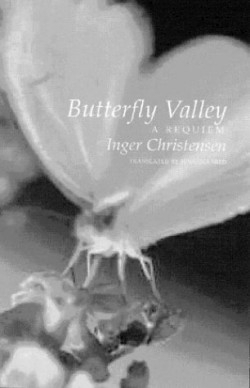Butterfly Valley
A Requiem
To call the author a formalist is to radically underemphasize just what an iconoclast she is. Her collection splits into four long sectioned poems, each with its own ordering principle, from the more traditional crown of sonnets of “Butterfly Valley: A Requiem” to the atypical splintering effect of “Watersteps.” Christensen’s formal precision deserves praise because it compels the poem. Structuring language and thought tenses against the chaos of nature and man, giving each poem a precarious balance to maintain through the strictures of both language and form.
A contender for the Nobel after being awarded the Nordic Prize of the Swedish Academy, Christensen is an institution in her native Denmark as well as throughout Europe. She received the Austrian State Prize for Literature and writes across the genres, almost always to critical acclaim. Here, she again tests the limits of her powers. As butterflies move in through a quiet summer valley, the poet-speaker considers them carefully for what they might represent: “it will soothe my terror of the void / to characterize butterflies as souls / and summer visions of the vanished dead.”
The crown of sonnets in which this appears consists of fifteen poems. The last line of the first poem becomes the first line of the second poem and the pattern continues, culminating finally in a poem that is composed of all the repeated lines. It is a testament to Christensen’s craft that she can create a coherent, lyric poem about pondering death and life out of what initially seem to be disparate lines.
For the non-traditionalist, Christensen plays with a kind of prose poem litany in “Meeting,” redefining the word in multiple sections, exploring the implications of a meeting with fate, with the end of a relationship, with the beginning of forgiveness. “Poem on Death” sprawls across the page in four-line stanzas, pondering “what if we always / could be here on the earth / which earthly condition / would we call death then // and which death call life.” The path of a writer, a red Ferrari, and a series of fountains is traced in “Watersteps,” from the history of the waterways to the sudden appearance of the omnipresent car. The poem builds into a kind of film, cobbled from bits of images, all rife with portent.
For readers curious about European poetry, Christensen’s work is a portal into a whole other world of formal invention and imagistic integrity. She writes of admiral butterflies: “with butterfly proboscis they are able / to breathe the world as an image-fable / light as the gliding flight of a caress, // till every spark of love is used, and just / beauty’s and terror’s vying sparks remain.”
She might just as well be speaking of her poems.
Reviewed by
Camille-Yvette Welsch
Disclosure: This article is not an endorsement, but a review. The publisher of this book provided free copies of the book to have their book reviewed by a professional reviewer. No fee was paid by the publisher for this review. Foreword Reviews only recommends books that we love. Foreword Magazine, Inc. is disclosing this in accordance with the Federal Trade Commission’s 16 CFR, Part 255.

